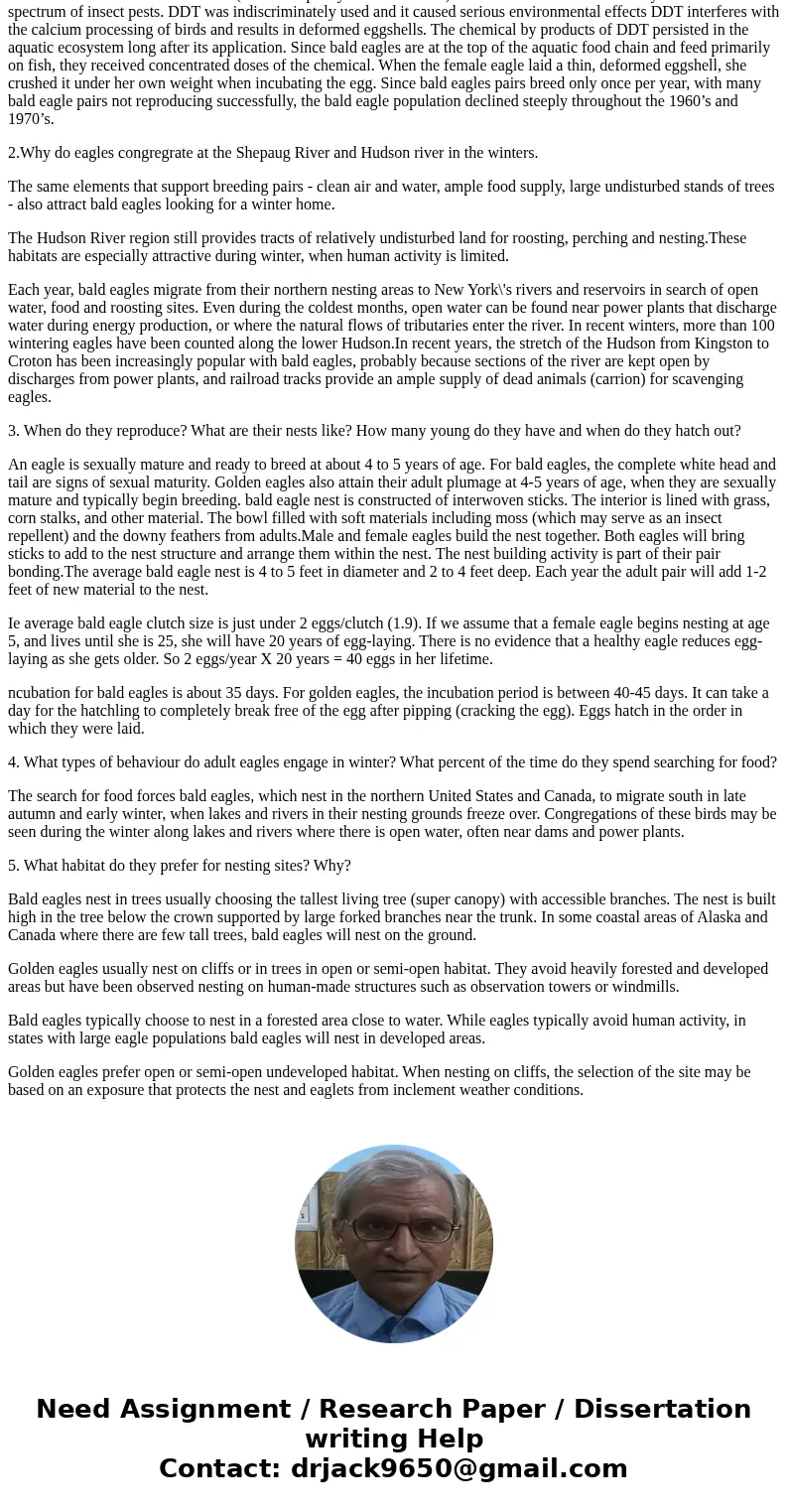Why did eagle populations decline in the 1960s Why do eagles
Solution
Answer:
1. Why did eagle populations decline in 1960s: Different reasons contributed to a steep decline in Eagle population in 1960s:
- More than 100,000 bald eagles were killed in Alaska from 1917 to 1953 as Alaskan Salmon fisherman feared that Eagles were a threat to the Salmon population
- In the 1950’s the insecticide DDT (dichlorodiphenyltrichloroethane) was introduced and used widely to combat a broad spectrum of insect pests. DDT was indiscriminately used and it caused serious environmental effects DDT interferes with the calcium processing of birds and results in deformed eggshells. The chemical by products of DDT persisted in the aquatic ecosystem long after its application. Since bald eagles are at the top of the aquatic food chain and feed primarily on fish, they received concentrated doses of the chemical. When the female eagle laid a thin, deformed eggshell, she crushed it under her own weight when incubating the egg. Since bald eagles pairs breed only once per year, with many bald eagle pairs not reproducing successfully, the bald eagle population declined steeply throughout the 1960’s and 1970’s.
2.Why do eagles congregrate at the Shepaug River and Hudson river in the winters.
The same elements that support breeding pairs - clean air and water, ample food supply, large undisturbed stands of trees - also attract bald eagles looking for a winter home.
The Hudson River region still provides tracts of relatively undisturbed land for roosting, perching and nesting.These habitats are especially attractive during winter, when human activity is limited.
Each year, bald eagles migrate from their northern nesting areas to New York\'s rivers and reservoirs in search of open water, food and roosting sites. Even during the coldest months, open water can be found near power plants that discharge water during energy production, or where the natural flows of tributaries enter the river. In recent winters, more than 100 wintering eagles have been counted along the lower Hudson.In recent years, the stretch of the Hudson from Kingston to Croton has been increasingly popular with bald eagles, probably because sections of the river are kept open by discharges from power plants, and railroad tracks provide an ample supply of dead animals (carrion) for scavenging eagles.
3. When do they reproduce? What are their nests like? How many young do they have and when do they hatch out?
An eagle is sexually mature and ready to breed at about 4 to 5 years of age. For bald eagles, the complete white head and tail are signs of sexual maturity. Golden eagles also attain their adult plumage at 4-5 years of age, when they are sexually mature and typically begin breeding. bald eagle nest is constructed of interwoven sticks. The interior is lined with grass, corn stalks, and other material. The bowl filled with soft materials including moss (which may serve as an insect repellent) and the downy feathers from adults.Male and female eagles build the nest together. Both eagles will bring sticks to add to the nest structure and arrange them within the nest. The nest building activity is part of their pair bonding.The average bald eagle nest is 4 to 5 feet in diameter and 2 to 4 feet deep. Each year the adult pair will add 1-2 feet of new material to the nest.
Ie average bald eagle clutch size is just under 2 eggs/clutch (1.9). If we assume that a female eagle begins nesting at age 5, and lives until she is 25, she will have 20 years of egg-laying. There is no evidence that a healthy eagle reduces egg-laying as she gets older. So 2 eggs/year X 20 years = 40 eggs in her lifetime.
ncubation for bald eagles is about 35 days. For golden eagles, the incubation period is between 40-45 days. It can take a day for the hatchling to completely break free of the egg after pipping (cracking the egg). Eggs hatch in the order in which they were laid.
4. What types of behaviour do adult eagles engage in winter? What percent of the time do they spend searching for food?
The search for food forces bald eagles, which nest in the northern United States and Canada, to migrate south in late autumn and early winter, when lakes and rivers in their nesting grounds freeze over. Congregations of these birds may be seen during the winter along lakes and rivers where there is open water, often near dams and power plants.
5. What habitat do they prefer for nesting sites? Why?
Bald eagles nest in trees usually choosing the tallest living tree (super canopy) with accessible branches. The nest is built high in the tree below the crown supported by large forked branches near the trunk. In some coastal areas of Alaska and Canada where there are few tall trees, bald eagles will nest on the ground.
Golden eagles usually nest on cliffs or in trees in open or semi-open habitat. They avoid heavily forested and developed areas but have been observed nesting on human-made structures such as observation towers or windmills.
Bald eagles typically choose to nest in a forested area close to water. While eagles typically avoid human activity, in states with large eagle populations bald eagles will nest in developed areas.
Golden eagles prefer open or semi-open undeveloped habitat. When nesting on cliffs, the selection of the site may be based on an exposure that protects the nest and eaglets from inclement weather conditions.


 Homework Sourse
Homework Sourse